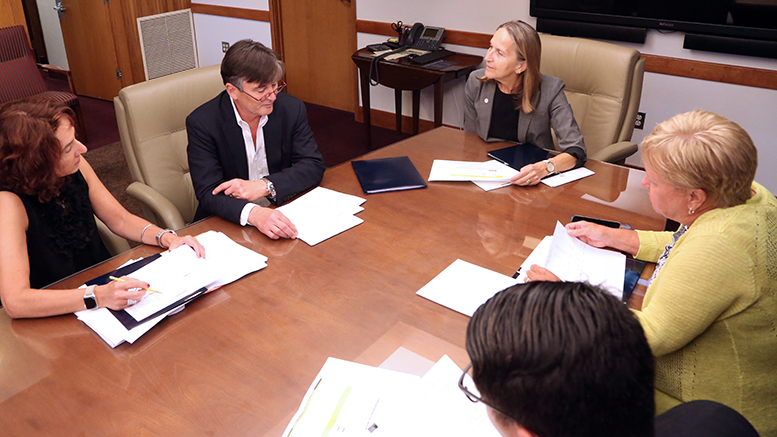For community college leaders, maintaining affordability is a high priority and raising tuition is a last resort. But ensuring the college is providing a high-quality education that is also a good value for students is a delicate balancing act when state and local funds fail to keep pace with rising costs and enrollment declines.
When the governor of Missouri announced an $86 million cut in higher education funding earlier this year, leaders of St. Louis Community College (STLCC) felt they had to raise tuition 5 percent for the fall 2019 semester. But after state appropriators restored those dollars, the college rescinded its tuition increase.
Students who had already registered at the higher rate were given a refund, says STLCC Vice Chancellor for Finance and Administration Paul Zinck. The college notified all students and staff and put out a press release letting the community know that the tuition rate would remain the same as last year.
“We could have left the higher fees in place and sought other ways to spend that revenue,” Zinck says. “Our board of trustees wanted us to not have that impact on students.” When the trustees initially approved the tuition hike, “it was with the stipulation that we would adjust the increase” if the final state budget doesn’t cut funding.
Crafting the budget
The budgeting process for STLCC begins with an estimate of the three main sources of revenue – tuition and fees, property tax receipts and state appropriations – followed by an estimate of credit enrollment. Zinck also considers whether adjustments are needed to account for other expenses, such as capital costs, facilities repairs, new programs and debt service.
The college leadership then makes a recommendation to the board to increase, reduce or maintain the current tuition.
“If we have a reason to think we need to increase tuition or fees, we look at local economic conditions and the impact on student enrollment,” Zinck says. “If raising tuition results in fewer people likely to enroll, that doesn’t really help us.”
The need to remain affordable is an important part of the budget discussions, he says, noting that a large proportion of students rely on federal aid. “It’s important to our mission to provide value to our community.”
Maintaining affordability is also critical in the budget decisions at Atlantic Cape Community College in New Jersey, where the leadership “is mindful that college costs have risen and students’ fiscal resources may be limited,” says Chief Financial Officer Leslie Jamison.
Because costs are outpacing state and local revenue, Atlantic Cape raised the fall 2018 in-county general tuition rate by $7.40 per credit hour, which amounts to a 6 percent increase from last year. Tuition and fees account for more than 58 percent of the FY 2019 operating budget.
In setting tuition rates, college administrators consider projected enrollment changes, as well as the expected amount of public funds and other revenue sources, Jamison says. The operating budget is aligned with the college’s strategic goals, and “a balance must be made to ensure that Atlantic Cape has the resources to provide experienced faculty and staff, updated instructional technology, student services and facilities.”
‘Budget fest’
Central New Mexico Community College (CNM) raised tuition for the coming semester by just 1.5 percent, which amounts to less than a dollar per credit, says President Katharine Winograd.
That decision was made following an extensive budget process, which CNM calls “budget fest.” Every dean and department makes a presentation about their needs, and every budget request has to be directly connected to the college’s strategic plan, which outlines 24 priorities.
Enrollment has leveled off but had been declining in recent years, while state funding is not increasing. Tuition has been relatively consistent in recent years at around $60 per credit hour.
“We can’t raise tuition to a place where students can’t afford to come,” Winograd says, “We can’t use tuition to offset our ability to make some tough decisions. We can’t put higher education problems on the backs of our students.”

Remaining affordable for students at Central New Mexico Community College is a crucial part of the college’s budget-development process. (Photo: CNM)
As a result, CNM has created another funding source, focusing on innovation. CNM Ingenuity Inc., a 501(c)(3), hosts a 10-week, non-credit coding boot camp that charges a higher rate and attracts people from out of state, including many who already have bachelor’s degrees and are looking to advance in their careers.
In another innovation, the college bought several houses and two apartment complexes in a declining neighborhood near its main campus. Students in building trades programs renovate them for resale, which has so far netted the college a profit of about $300,000.
Other CNM Ingenuity projects include a business accelerator where the college provides coaches to student entrepreneurs and shares in their profits. CNM has so far invested in student-created software and handyman businesses. It also hosts small student-owned businesses in a maker space.
“What we’re trying to do is twofold – we’re changing lives and building community,” Winograd says. And because the community is still struggling after the economic downturn of 2009-10, “we’re also trying to build a workforce that will stay in New Mexico and be a part of the community we love.”
To control costs, the college carried out a number of reorganizations over the past few years to ensure it’s meeting the needs of the workforce while remaining affordable. In one example, CNM hires people who can use technology to create efficiencies in its administrative functions.
Since Winograd became president 12 years ago, no one has been laid off, she says. Instead, some vacant positions have not been filled, some staff have been retrained and transferred to other positions and the college has offered more generous retirement incentives.
In the past, when the college used advertising and social media to recruit students, the focus was on quality, and the college was reluctant to talk about affordability, Winograd says. Now that the college’s tuition is a fifth of what the university across the street charges, the message is that CNM offers a high-quality education that is also affordable.
A balancing act
Faced with declining revenue, Dutchess Community College (DCC) in New York, raised tuition for the 2018-19 academic year by $84 a semester. That comes to an annual tuition rate of $3,864.
Even with the increase, DCC still has the lowest tuition in the state, a position it’s held for the past 16 years, says President Pamela Edington.
“We don’t want to make changes in tuition. We’re trying to do modest increases on an annual basis to ensure we remain affordable,” she says.
DCC has three main sources of revenue: the state, through the State University of New York (about 27 percent); the county legislature (24 percent); and student tuition and fees (34 percent). The rest comes from a range of sources, such as noncredit workforce programs, the K-12 system for dual-enrollment students, tuition from out-of-county students and community services.
County funding to the college has been rising; this year’s funding increase of $1.75 million is the largest increase ever. And while the state also increased its contribution, its allocation formula is based on FTE, which translates into less funding, as enrollment has dropped from a peak of about 10,000 10 years ago to 8,000 now.
“One of the hardest questions we face is, if enrollment is going down, why aren’t expenses going down?” Edington says.
The largest expenditure in DCC’s $70 million budget is faculty and staff. “Our personnel costs and benefits continue to rise. There’s only so much you can do,” she says. The college is examining every position and offers early retirement incentives. Building maintenance costs are also hard to cut, although the college is reducing its energy costs. A growing use of online educational resources has curbed students’ textbook costs.
Despite these measures, “excellent education is expensive,” Edington says. “The student population coming to the college needs more support than ever.” DCC has a food pantry, provides free bus transportation and increased its emergency fund for students. “You can’t cut those costs,” she says.
Ensuring access to college is only part of the equation, Edington says. “Students need high value. That means investing in faculty to ensure students get a first-rate education.”
“These are very challenging times,” she adds. “That requires us to be creative and to think more broadly about how to make college more affordable.”

